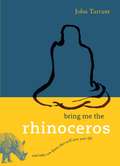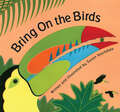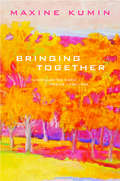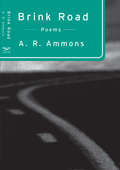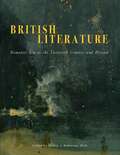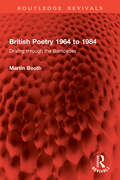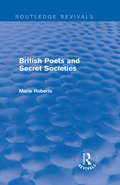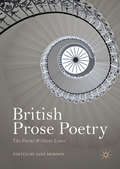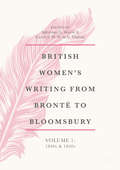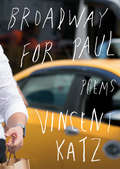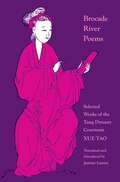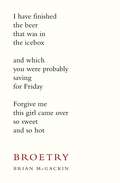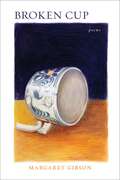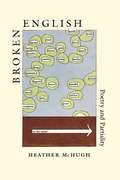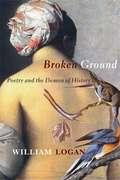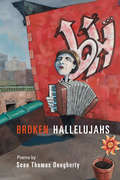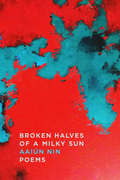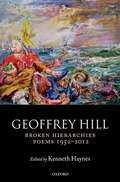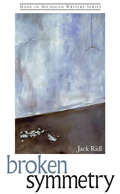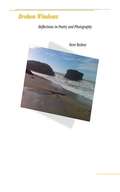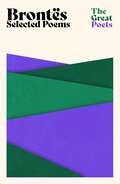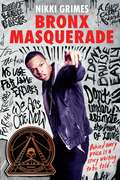- Table View
- List View
Bring Me The Rhinoceros: And Other Zen Koans That Will Save Your Life
by John TarrantBring Me the Rhinoceros is an unusual guide to happiness and a can opener for your thinking. For fifteen hundred years, Zen koans have been passed down through generations of masters, usually in private encounters between teacher and student. This book deftly retells more than a dozen traditional koans, which are partly paradoxical questions dangerous to your beliefs and partly treasure boxes of ancient wisdom. Koans show that you don't have to impress people or change into an improved, more polished version of yourself. Instead you can find happiness by unbuilding, unmaking, throwing overboard, and generally subverting unhappiness. John Tarrant brings the heart of the koan tradition out into the open, reminding us that the old wisdom remains as vital as ever, a deep resource available to anyone in any place or time.
Bring on the Birds
by Susan StockdaleBrightly colored, richly textured illustrations and an energetic rhyming text introduce young readers to birds and their unique qualities. Birds come in all sorts of interesting shapes, sizes, and colors—and many of them can do amazing things as well. From the Blue-footed Booby to the Red-billed Oxpecker, the breadth of bird life depicted in this stunning book will captivate young ornithologists. Susan Stockdale's bold colors and crisp, clean lines capture the reader's attention and introduce us to a remarkable world filled with distinctive creatures. An afterword identifies each animal and tells a little bit about it and where it lives.
Bringing Together: Uncollected Early Poems 1958-1989
by Maxine Kumin"The power that Kumin draws from and brings to literature is potent and seemingly inexhaustible."--Booklist Collected here for the first time, these early poems inhabit Kumin's own "sneakstorm time," a space one step to the side, where quiet introspection examines the pain of loss, the idealism of youth, and the endurance of the natural world. Her characteristic earthy wisdom snaps with intensity, offering a refreshing perspective on everyday experiences. "New England farm life, modern American history, Jewish identity and a quietly vibrant feminist consciousness provide themes for this gathering from a long and distinguished career."--Publishers Weekly.
Brink Road: Poems
by A. R. Ammons"No contemporary poet, in America, is likelier to become a classic than A. R. Ammons."—Harold Bloom With characteristic economy, A. R. Ammons writes that "Brink Road lies off NY 96 between Candor and Catatonk." The very name suggests that we are ever in transition from one state of mind to another always on the edge of revelation. The more than 150 poems in Brink Road date from 1973 to the present, dealing with Ammons's concerns with language, mortality, and the forces underlying the natural world. With elegance, wit, and ruminative gravity, Brink Road is an important addition to one of the most enduring bodies of poetry of our time.
British Literature: Romantic Era to the Twentieth Century and Beyond
by B J RobinsonThis open anthology of British Literature encompasses the following eras: Romantic, Victorian, and Twentieth Century and Beyond. The selections represent the literature developed and developing within and through their respective eras. Considering the limitations that the very act of anthologizing imposes, not all that could be representative is included. But what is included, hopefully, is literature that was shaped by its era and that helped shape the literature that followed. This anthology includes contextualizing Introductions to each era, Biographies of each author, and Reading and Review Questions on each author's included works. This material offers basic signposts toward critical interpretation and understanding of the selections. But they do not impose or intend to shape that understanding so students can instead hone their critical thinking skills and synthesize historical, cultural, and aesthetic concepts. With this open anthology, students can compare the selections both within and across historical eras to analyze shared themes. The theme of personal identity as inherent or as socially constructed opens a constellation of related themes, many of which students may take for granted or have not critically examined. Students can understand the revolutionary aspects of the Romantic era by considering how static and determined class distinctions of the eighteenth century became more fluid and conditional in the nineteenth century. They can understand how the Romantics, seeing past sources of identity within a stable class system catastrophically disrupted by revolutionary forces across Europe and ultimately within England, considered universal elements of individuality that were shared across all classes and that demonstrated fundamental equality among humans. Imagination became a touchstone of such shared humanity. Considering the theme of Imagination opens related themes of dream and nightmare, happiness and terror, truth and doubt (or self-truths and self-doubts). Categories of identity constructs--such as hero and monster--similarly become conditional or conditioned, for example, upon self-realization and social limitations. Students can consider how one era's literature influenced the next. Victorian poetry can suggest how revelation of self could be made objective and impersonal through dramatized monologues. A speaker's point of view can reveal truths about humanity--such as jealousy, control, hatred, and greed--that evoke both sympathy and rejection. Impersonality can then lead to the shifting impersonations of Modern literature. Ego and egotism can be deplored by Victorian writers but desired by the Moderns. The horrors of the twentieth century can subvert the heroics of the nineteenth. And the realization of these horrors can grow out of the very sense of individual rights that the Romantics expressed--rights shared across gender, race, and class. This anthology hopefully will open students (and readers) to the conversation that literature has held with readers in the past and is holding with us now.
British Poetry 1964 to 1984: Driving through the Barricades (Routledge Revivals)
by Martin BoothFirst published in 1985, British Poetry presents a personal and political account of British poetry from 1964 to 1984. Martin booth, himself a poet, poetry publisher, critic and editor, and the participant in poetry readings in Britain and overseas, shows that British poetry underwent a renaissance in the ten years from around 1964: poetry became a major popular art form, shaking off its shackles of elitism and academicism; poetry readings flourished, whether live or on the air and audiences increased; many new poets found willing publishers. He looks at the manner in which British poetry rose, only to fall back into a morbid sleek artiness where he sees it laying today, once again a narrow art for the literary educated and the initiated.The book aims to reverse this change of direction so that British poetry may once again have the impact it briefly had in its recent heyday. Martin Booth also provides a general guide to the period, with much comment included from those who were involved in the act of keeping British poetry going in those exciting years. He deals with the poets themselves, with the publishing of poetry, and poetry magazines, and his ‘non-literary’, ‘non-academic’ approach will appeal to all those who have an interest in modern British verse.
British Poets and Secret Societies (Routledge Revivals)
by Marie Mulvey-RobertsA surprisingly large number of English poets have either belonged to a secret society, or been strongly influenced by its tenets. One of the best known examples is Christopher Smart’s membership of the Freemasons, and the resulting influence of Masonic doctrines on A Song to David. However, many other poets have belonged to, or been influenced by not only the Freemasons, but the Rosicrucians, Gormogons and Hell-Fire Clubs. First published in 1986, this study concentrates on five major examples: Smart, Burns, William Blake, William Butler Yeats and Rudyard Kipling, as well as a number of other poets. Marie Roberts questions why so many poets have been powerfully attracted to the secret societies, and considers the effectiveness of poetry as a medium for conveying secret emblems and ritual. She shows how some poets believed that poetry would prove a hidden symbolic language in which to reveal great truths. The beliefs of these poets are as diverse as their practice, and this book sheds fascinating light on several major writers.
British Prose Poetry: The Poems Without Lines
by Jane MonsonThis book is the first collection of essays on the British prose poem. With essays by leading academics, critics and practitioners, the book traces the British prose poem’s unsettled history and reception in the UK as well as its recent popularity. The essays cover the nineteenth, twentieth and twenty-first centuries exploring why this form is particularly suited to the modern age and yet can still be problematic for publishers, booksellers and scholars. Refreshing perspectives are given on the Romantics, Modernists and Post-Modernists, among them Woolf, Beckett and Eliot as well as more recent poets like Seamus Heaney, Geoffrey Hill, Claudia Rankine, Jeremy Over and Vahni Capildeo. British Prose Poetry moves from a contextual overview of the genre’s early volatile and fluctuating status, through to crucial examples of prose poetry written by established Modernist, surrealist and contemporary writers. Key questions around boundaries are discussed more generally in terms of race, class and gender. The British prose poem’s international heritage, influences and influence are explored throughout as an intrinsic part of its current renaissance.
British Women's Writing from Brontë to Bloomsbury, Volume 1: 1840s and 1850s (British Women’s Writing from Brontë to Bloomsbury, 1840-1940 #1)
by Adrienne E. Gavin Carolyn W. de la L. OultonThis five-volume series, British Women’s Writing From Brontë to Bloomsbury, 1840-1940, historically contextualizes and traces developments in women’s fiction from 1840 to 1940. Critically assessing both canonical and lesser-known British women’s writing decade by decade, it redefines the landscape of women’s authorship across a century of dynamic social and cultural change. With each of its volumes devoted to two decades, the series is wide in scope but historically sharply defined. Volume 1: 1840s and 1850s inaugurates the series by historically and culturally contextualizing Victorian women’s writing distinctly within the 1840s and 1850s. Using a range of critical perspectives including political and literary history, feminist approaches, disability studies, and the history of reading, the volume’s 16 original essays consider such developments as the construction of a post-Romantic tradition, the politicization of the domestic sphere, and the development of crime and sensation writing. Centrally, it reassesses key mid-nineteenth-century female authors in the context in which they first published while also recovering neglected women writers who helped to shape the literary landscape of the 1840s and 1850s.
Broadway for Paul: Poems
by Vincent KatzFriendship, love, and the potential energy of change animate these poems of walking through New York City.Broadway, the famous artery, both off the grid and definitive of Manhattan as it cuts its way downtown, is a metaphor for Katz's path through these poems: from Lincoln Plaza on the Upper West Side to the African Burial Ground and the courthouses downtown, Katz mines his native city for the deep humanity that undergirds its streets. His title, with its implication that one could give something as large and undefinable as Broadway to a single person, courts an impossibility that generates the possibility of friendship, as well as the largesse Katz wants to find in our civic discourse. In poems such as "Ivanka Skirting" and "This Beautiful Bubble" we encounter his reckoning with a divisive culture that can, he suggests, be healed through our daily acts--through a kind of alert graciousness that also defines his poetry. In this moving collection, we enter Katz's world, both public and private, and experience poetry as a way of seeing that can change hearts and minds.
Brocade River Poems: Selected Works of the Tang Dynasty Courtesan (The Lockert Library of Poetry in Translation #122)
by Xue TaoXue Tao (A.D. 768-831) was well known as a poet in an age when all men of learning were poets--and almost all women were illiterate. As an entertainer and official government hostess, she met, and impressed, many of the most talented and powerful figures of her day. As a maker of beautiful paper and a Taoist churchwoman, she maintained a life of independence and aesthetic sensibility. As a writer, she crrated a body of work that is by turns deeply moving, amusing, and thought-provoking. Drawing knowledgeably on a rich literary tradition, she created images that here live again for the contemporary reader of English. This bilingual edition contains about two-thirds of Xue Tao's extant poems. The translations are based on accurate readings of the originals and extensive research in both Chinese and Japanese materials. The notes at the end of the book explain allusions and place the poems in the context of medieval Chinese culture and its great literary heritage, while the opening essay introduces Xue Tao's work and describes her unusual life history.
Broetry: Poetry for Dudes
by Brian McgackinAs contemporary poets sing the glories of birds, birch trees, and menstruation, regular guys are left scratching their heads. Who can speak for Everyman? Who will articulate his love for Xbox 360, for Mama Celeste's frozen pizza, for the cinematic oeuvre of Bruce Willis? Enter Broetry--a stunning debut from a dazzling new literary voice. "Broet Laureate" Brian McGackin goes where no poet has gone before--to Star Wars conventions, to frat parties, to video game tournaments, and beyond. With poems like "Ode to That Girl I Dated for, Like, Two Months Sophomore Year" and "My Friends Who Don't Have Student Loans," we follow the Bro from his high school graduation and college experience through a "quarter-life crisis" and beyond.From the Hardcover edition.
Broken Cup: Poems
by Margaret GibsonBroken Cup brings breathtaking eloquence to what Margaret Gibson describes as "traveling the Way of Alzheimer's" with her husband, poet David McKain. After his initial and tentative diagnosis, Gibson suspended her writing for two years; but then poetry returned, and the creative process became the lightning rod that grounded her and presented a path forward. The poems in Broken Cup bear witness to how Alzheimer's erodes memory and cognitive function, but they never forget to see what is present and to ask what may remain of the self. Moving and unflinchingly honest in the acknowledgment of pain, frustration, and grief, the poems uncover, time and time again, the grace of abiding love. Gibson gives heart as well as voice to an experience that is deeply personal, yet shared by all too many.
Broken English: Poetry and Partiality
by Heather Mchugh"When I call poetry a form of partiality," writes Heather McHugh, "I mean its economies operate by powers of intimation: glimmering and glints, rather than exhaustible sums. It is a broken language from the beginning, brimming with non-words: all that white welled up to keep the line from surrendering to the margin; all that quiet, to keep the musics marked." In Broken English, McHugh applies her poetic sensibility and formidable critical insight to topics ranging from the poetry of Valery and Rilke to ancient Greek drama and Yoruba folk songs, offering intense, passionate, highly personal readings that are informed and unified by her concern for the relationships among language, culture, and poetry. Ebook Edition Note: All images have been redacted.
Broken Glory: The Final Years of Robert F. Kennedy
by Ed Sanders Rick VeitchBobby Kennedy's last campaign-an homage to a leader who might have changed history and a reconstruction of the conspiracy to stop him, in a magisterial feat of epic investigative poetry. June 5, 2018, is the fiftieth anniversary of the assassination of Robert F. Kennedy, and there are still unanswered questions about whether his murder was the result of a conspiracy. Broken Glory is a graphic history told in epic verse of Bobby Kennedy's life and times leading up to the fateful 1968 election campaign, with 100 illustrations by artist Rick Veitch. It encompasses the story of his convicted killer, Sirhan Sirhan, as well as a large cast of characters that includes Lyndon Johnson, J. Edgar Hoover, Richard Nixon, and Eugene McCarthy, who was the first to challenge the sitting president of his own party in the 1968 election, and it recalls the major events that made 1968 a turning point in American history: the Tet offensive and battle of Hue, followed soon after by the My Lai massacre, the assassination of Martin Luther King, and the riots that ensued. The authors illuminate the evidence for a conspiracy, fostered perhaps by elements of the CIA, that fielded a second shooter and made of Sirhan Sirhan a patsy, mirroring the part played by Lee Harvey Oswald in the assassination of John F. Kennedy, an event that haunted JFK’s younger brother until his dying day.
Broken Ground: Poetry and the Demon of History
by William LoganIn Broken Ground, William Logan explores the works of canonical and contemporary poets, rediscovering the lushness of imagination and depth of feeling that distinguish poetry as a literary art. The book includes long essays on Emily Dickinson’s envelopes, Ezra Pound’s wrestling with Chinese, Robert Frost’s letters, Philip Larkin’s train station, and Mrs. Custer’s volume of Tennyson, each teasing out the depths beneath the surface of the page.Broken Ground also presents the latest run of Logan’s infamous poetry chronicles and reviews, which for twenty-five years have bedeviled American verse. Logan believes that poetry criticism must be both adventurous and forthright—and that no reader should settle for being told that every poet is a genius. Among the poets under review by the “preeminent poet-critic of his generation” and “most hated man in American poetry” are Anne Carson, Jorie Graham, Paul Muldoon, John Ashbery, Geoffrey Hill, Louise Glück, John Berryman, Marianne Moore, Frederick Seidel, Les Murray, Yusef Komunyakaa, Sharon Olds, Johnny Cash, James Franco, and the former archbishop of Canterbury.Logan’s criticism stands on the broken ground of poetry, soaked in history and soiled by it. These essays and reviews work in the deep undercurrents of our poetry, judging the weak and the strong but finding in weakness and strength what endures.
Broken Hallelujahs
by Sean Thomas DoughertyFusing street scenes (from Budapest to New York City) with family history (African American and Jewish), Sean Thomas Dougherty uses both traditional and experimental forms to explore issues of identity and family. Deeply rooted in music and performance, Dougherty's poetry resists easy categorization, revealing the complexity of our lives and times. Sean Thomas Dougherty lives in Erie, Pennsylvania, where he teaches in the BFA program for creative writing at Penn State Erie. He is a nationally renowned performance poet and author of nine previous poetry collections. He was a finalist for the 2005 Paterson Poetry Prize and winner of the 2000 Pinyon Press Poetry Prize.
Broken Hallelujahs (American Poets Continuum)
by Sean Thomas DoughertyFusing street scenes (from Budapest to New York City) with family history (African American and Jewish), Sean Thomas Dougherty uses both traditional and experimental forms to explore issues of identity and family. Deeply rooted in music and performance, Dougherty&’s poetry resists easy categorization, revealing the complexity of our lives and times. Sean Thomas Dougherty lives in Erie, Pennsylvania, where he teaches in the BFA program for creative writing at Penn State Erie. He is a nationally renowned performance poet and author of nine previous poetry collections. He was a finalist for the 2005 Paterson Poetry Prize and winner of the 2000 Pinyon Press Poetry Prize.
Broken Halves of a Milky Sun: Poems
by Aaiún NinWith the emotional undertow of Ocean Vuong and the astute political observations of Natalie Diaz, a powerful poetry debut exploring the effects of racism, war and colonialism, queer love and desire. In their breathtaking international debut, Aaiún Nin plumbs the depths of the lived and enduring effects of colonialism in their native country, Angola. In these pages, Nin untangles complexities of exile, the reckoning of familial love, but also reveals the power of queer love and desire through the body that yearns to love and be loved. Nin shows the ways in which faith and devotion serve as forms of oppression and interrogates the nature of home by reclaiming the persistent echoes of trauma. A captivating blend of evocative prose and intimate testimony, Nin speaks to the universal vulnerability of existence.
Broken Hierarchies
by Geoffrey Hill Kenneth HaynesBroken Hierarchies brings together twenty books of poems by Geoffrey Hill, offering a complete collection of his poetry from 1952-2012.
Broken Symmetry: Broken Symmetry
by Jack RidlMichigan poet Jack Ridl leads readers into reflective connection with the everyday world in this unique and enjoyable volume.
Broken Windows: Reflections in Poetry and Photography
by Steve BedneyWithin this group of poems are reflections on love, loss, and pain, some on an individual level, but others on a grander scale. They represent a decline into the darkness, and a struggle and a hope to climb back to the light. From the depths of the aftermath of tragedy to the solitude of being along on a holiday, to finding a way back out the other side, there are stories to be told and answers out there to find. Each can be taken alone or as a part of a whole. Each represents one step on the road to the journey on which we travel.
Brontes: Selected Poems (The Great Poets)
by Anne Bronte Charlotte Bronte Emily BronteThe Bronte sisters lives and works have become modern-day cultural touchstones.Emily Bronte, best known for her novel WUTHERING HEIGHTS, began writing poetry first and, before her untimely death, wrote some of the most touching and emotive poems which often reflected the landscape of her Yorkshire home.Charlotte Bronte, whose novel JANE EYRE has had numerous TV and film adaptations, took responsibility for finding a home for their work. In her own words, ' We had very early cherished the dream of one day becoming authors'.Anne Bronte, author of AGNES GREY, often used autobiographical elements in her poems, giving us a hints of the struggles and turmoil of her life.These poems offer glimpses of the joys and sorrows of the Brontes and are a beautifully compelling introduction to their writing and lives.
Brontes: Selected Poems (The Great Poets)
by Anne Bronte Charlotte Bronte Emily BronteThe Bronte sisters lives and works have become modern-day cultural touchstones.Emily Bronte, best known for her novel WUTHERING HEIGHTS, began writing poetry first and, before her untimely death, wrote some of the most touching and emotive poems which often reflected the landscape of her Yorkshire home.Charlotte Bronte, whose novel JANE EYRE has had numerous TV and film adaptations, took responsibility for finding a home for their work. In her own words, ' We had very early cherished the dream of one day becoming authors'.Anne Bronte, author of AGNES GREY, often used autobiographical elements in her poems, giving us a hints of the struggles and turmoil of her life.These poems offer glimpses of the joys and sorrows of the Brontes and are a beautifully compelling introduction to their writing and lives.
Bronx Masquerade
by Nikki GrimesThis award-winning novel is a powerful exploration of self, an homage to spoken-word poetry, and an intriguing look into the life of eighteen teens.When Wesley Boone writes a poem for his high school English class, some of his classmates clamor to read their poems aloud too. Soon they're having weekly poetry sessions and, one by one, the eighteen students are opening up and taking on the risky challenge of self-revelation. There's Lupe Alvarin, desperate to have a baby so she will feel loved. Raynard Patterson, hiding a secret behind his silence. Porscha Johnson, needing an outlet for her anger after her mother OD's. Through the poetry they share and narratives in which they reveal their most intimate thoughts about themselves and one another, their words and lives show what lies beneath the skin, behind the eyes, beyond the masquerade.
